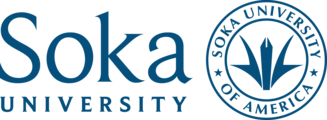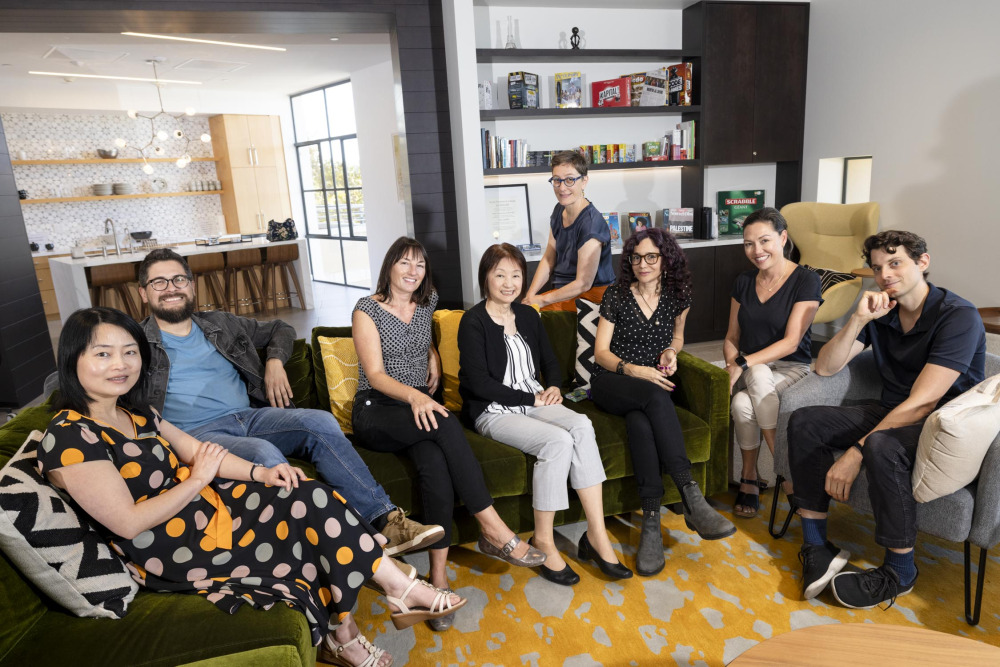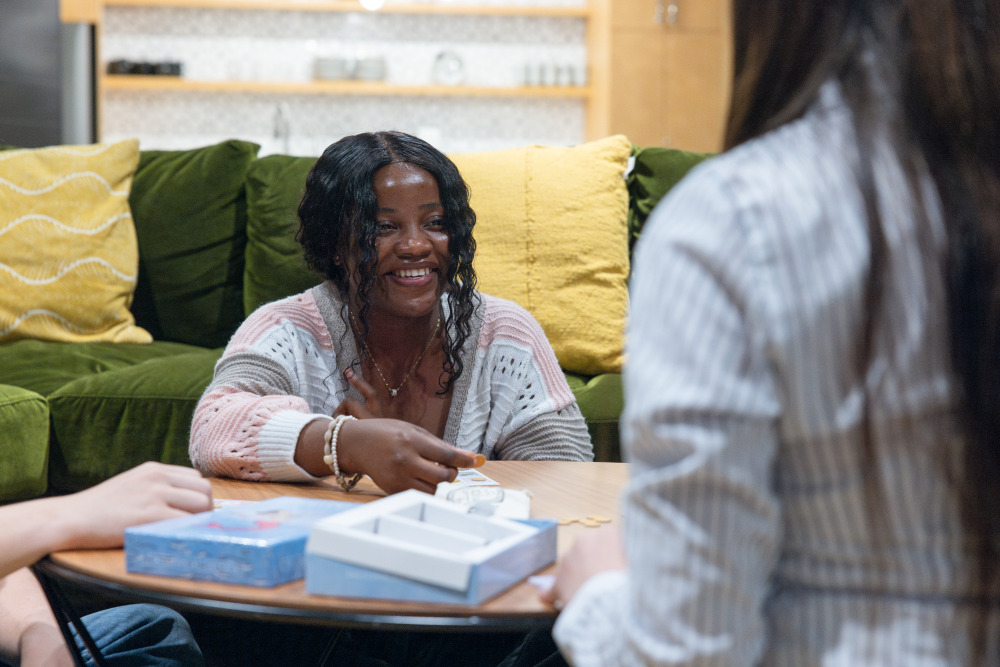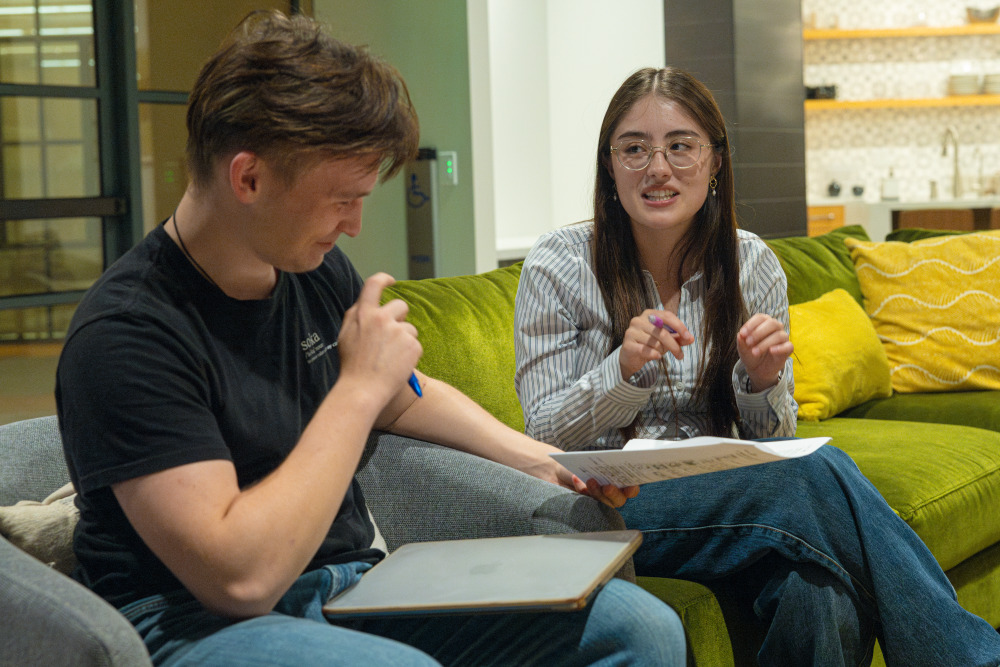“Opening a Window to the World”: Inside the Language and Culture Program at SUA

“Learning a new language transforms how students perceive and interpret the world,” said Sandrine Siméon, associate professor of French, assistant dean of global citizenship, and director of Soka University of America’s Language and Culture Program. For SUA students, that transformation begins long before they study abroad during their junior year, supported by language and culture learning that expands their worldview and fosters their growth as global citizens.
The Language and Culture Program is part of the general education that every SUA student completes while earning their B.A. in liberal arts. Even if students are already fully bilingual or multilingual, they must select a new language to learn. Students take four semesters of Chinese, French, Japanese, or Spanish in preparation for studying abroad in a country where their target language is spoken. Although they are not required to take additional language and culture courses after returning from study abroad, many students take advantage of their newly improved fluency and cultural understanding to dive into upper division courses in their target language, exploring topics like literature, film, linguistics, cultural history, and contemporary issues.
Cultural learning plays an essential role in how languages are taught at every level of the Language and Culture Program, from foundational language instruction to conversation, composition, and advanced seminar-style courses.
“You can’t just study language as a code,” said Osamu Ishiyama, associate professor of Japanese language and culture. “It comes with the whole package. That’s why there are things that you can express very well in one language but not in another. Language embodies culture.”
SUA language faculty and alumni stress that learning a new language is a highly important and relevant skill, even in our age of translation apps and AI.
“Language is more than words,” Siméon said. “It reflects how people think, relate, and live. Without understanding culture, communication stays superficial.”
Tokyo native Koichi Hagimoto ’05, who learned Spanish at SUA and is now a tenured Spanish professor and department chair at Wellesley College, argues that “learning a new language remains crucial because it connects people from diverse backgrounds and creates a shared sense of humanity.”
What Language Learning Looks Like in an SUA Classroom
Before beginning their first semester at SUA, students can take a placement exam to determine their level of proficiency if they already have experience in the language they would like to study. This provides an opportunity for students to continue studying a language they may have begun to learn in high school, or for heritage speakers to enter the program at a level that reflects their skills. However, if a student places above the 400 level, they must select another language to study. Beginners in a new language can enroll in 101 directly.
Once students enter the classroom, they’re immersed in the target language as much as possible. Instructors often take a communicative approach, which emphasizes the importance of interaction and conversation practice, or a task-based approach, which prioritizes students’ ability to accomplish everyday tasks in the target language. The small class sizes — with a maximum of 12 students per class — promote a nurturing environment where students can feel comfortable asking questions and making mistakes.
Language classes often pair textbooks with authentic materials — literature, journalism, film, and podcasts created for native speakers. This approach helps students learn grammar and vocabulary through meaningful, real-world contexts.
“We focus on giving students a real piece of the culture,” said Elena Cardona, assistant teaching professor of Spanish language and culture. For example, one of her classes recently watched the 2010 film “También la lluvia” (“Even the Rain”). The film portrays a Spanish film crew making a movie about Christopher Columbus’ first voyage to Hispaniola, which they are shooting in Bolivia at a time when there are mass protests against the privatization of water.
“This is not only a way for students to expand their vocabulary, but also to engage with contemporary issues and the history of relations between Spain and Latin America,” Cardona said. “They can engage with global concerns and relate it to their own interests and experiences.”
As adult learners, college students can also benefit from more in-depth, rational explanations of challenging concepts, so professors occasionally break down especially complex skills or grammatical structures into logical patterns. For example, Sijia Yao, assistant professor of Chinese language and culture, uses a more integrative approach when teaching Chinese characters, rather than fully adopting the traditional method of committing the characters to muscle memory through repetitive writing.
“I show students how to identify the major components of each character and make sense of it,” Yao said. “That’s a really important entry point.”
Culture Learning in the Classroom and Beyond
The program also provides many hands-on learning opportunities so students can experience the culture from their very first semester.
“Within the classroom setting, we participated in activities celebrating various Japanese holidays, allowing us to learn about traditional customs and practices,” said alumna and current graduate student Leandra González Pérez ’22 M.A. ’26. “In Chieko Miyama’s Japanese 100- and 200-level courses, we occasionally prepared Japanese dishes under her guidance, which further enriched our cultural understanding.”
Classes often take field trips to festivals and museums, taking advantage of the rich cultural resources available in Southern California. Faculty also encourage students to practice their language skills off campus by engaging with native speakers in Orange County.
“We’re so close to Spanish-speaking communities here,” said Verónica Quezada, associate professor of Spanish language and culture. She encourages students every year to attend the Día de los Muertos (Day of the Dead) festival in downtown Santa Ana, which is organized by El Centro Cultural de México.
Another major focus of language instruction at SUA is preparing students to study abroad, especially as they approach their third year. Beyond developing language skills and cultural knowledge, the goal is to help students “learn how to be sophisticated intercultural communicators,” explained Pablo Camus-Oyarzun, associate professor of Spanish language and culture. This means developing the empathy and open-mindedness to see the world from the perspective of other cultures, understanding their values and beliefs even when they don’t align with students’ own worldviews.
“When you learn how to communicate across cultures, it’s not something that’s relegated to the classroom,” Camus-Oyarzun said. “It becomes a lifelong learning process.”
And SUA — perhaps more than any other college campus in the U.S. — provides an incredible environment for students to start practicing this kind of intercultural communication. Roughly 50% of SUA’s student population is international, with students coming from over 40 nations across six continents. Cultural exchange is part of everyday life for Soka students. And with every language taught at SUA represented among the student body, students can practice their target language with peers. For Lev Nakamura ’26 of Yoshkar-Ola, Russia, getting to know his Japanese classmates helped him “learn about the culture and language more directly and naturally.”
Students also have access to free peer tutoring sessions with native speakers four nights a week at the Ikeda Library or the Global Language and Culture Center (GLCC). González Pérez, who is from Cuba and grew up in Miami, tutored fellow students in Spanish and received tutoring in Japanese from her classmates.
“This allowed us to exchange roles, supporting each other’s language learning in a collaborative and mutually beneficial way,” she said. “It not only deepened my appreciation of Japanese culture, but also helped foster meaningful friendships.”
The GLCC also serves as a space for cultural events like film series, crêpe parties, and guest lectures hosted by faculty or student-led culture clubs. On weekday mornings, students can drop by to take advantage of the books, films, and games in their target language.
Visitors to the French-language shelves in the GLCC may notice a framed certificate from Pi Delta Phi, the national French honor society. Thanks to efforts spearheaded by David Vivian, visiting assistant professor of French, SUA now has a chapter of this prestigious honor society, giving French language students the opportunity to apply for scholarships and enhance their resumes and graduate school applications. This is just one example of the many ways the Language and Culture Program bridges language learning with broader opportunities for success.
Confidence and Cultural Competency: A Foundation for a Fulfilling Career
The Language and Culture Program has had a profound impact on students’ futures, influencing their senior capstone topics, fields of graduate study, and career opportunities.
“My ability to speak French has become an asset,” said Vibhu Walia ’22, who is originally from Kurukshetra, India. After graduating from SUA, he attended business school in France. He now works for a financial services company in Singapore, where he sometimes collaborates with francophone colleagues. Beyond language skills, Walia credits the Language and Culture Program with helping him develop his sense of inquiry.
“Learning French unlocked new histories, cultures, and ways of thinking,” Walia said. “Even before studying abroad, I was struck by how often English borrowed from French, revealing intricate layers of cultural exchange. Tracing these etymological threads felt like traveling through centuries of interaction across the English Channel.”
Language and culture study, together with studying abroad, can foster tremendous personal growth.
“Coming back from study abroad, some students have really gained confidence,” Ishiyama said. “They are almost like a different person. They understand the power of connecting with other people and how language embodies that, practically and symbolically.”
An increase in confidence played a key role in Jessica Delgadillo’s ’15 experience in the Language and Culture Program. Growing up in Orange County as a heritage speaker, she could understand spoken Spanish, but she didn’t have experience using the language in academic and professional settings until she studied Spanish at SUA and spent a semester abroad in Quito, Ecuador.
“I developed a sense of determination and overcame insecurities and imposter syndrome,” she said. She went on to complete a senior capstone on Chilean political music and later earned a graduate degree in Chicano studies with a focus on Chicana art and poetry. She now works as an arts educator in Los Angeles County, where she serves many students who come from Spanish-speaking households.
“You Never Know What Doors It Might Open”: Advice for Current Language and Culture Students
Students, faculty, and alumni alike have lots of advice for students on how to get the most out of the Language and Culture Program at SUA. First of all, faculty members say approaching language study simply as a graduation requirement often won’t get you very far. It can make a big difference to reflect on your deeper purpose for learning a new language and find a personal connection to it.
“The moment you have a goal with the language, whether it’s a professional goal or a personal one, the language-learning trajectory goes much more smoothly,” Camus-Oyarzun said.
Miyuki Takeda ’25 of Osaka, Japan, found this deeper purpose when she studied abroad in Taipei, Taiwan. She was not planning on continuing to study Chinese after her semester abroad, but the friendship she developed with her host family motivated her to continue learning so she could stay in touch with them in a meaningful way.
“The precious experiences and interactions I had throughout the semester made me think that I wanted to learn more, not just as skills, but as tools to communicate,” Takeda said.
Because studying abroad is an enormous boost to fluency, students, alumni, and faculty alike recommend taking upper division language courses after returning to campus. Shinsaku Shiode ’26 was not planning on taking more Chinese courses beyond the minimum requirements, but after his first month studying abroad in Beijing, something clicked.
“I realized that the foundational knowledge I gained at SUA was crucial in helping me adapt and progress rapidly while studying abroad,” Shiode said. “More importantly, I began to genuinely enjoy learning the language and engaging with Chinese culture.” Inspired by this experience, Shiode has enrolled in two upper division Chinese courses since returning to campus last spring.
Faculty stress that post-study abroad is a critical time to continue strengthening language skills so students can confidently apply them in academic and professional settings. It’s crucial to keep practicing so you don’t lose hard-earned progress.
“Put real effort into developing fluency,” said Dimitri Tiatia-Garaud ’17 of Vanosc, France. “You never know what unexpected doors it might open for you in the future.” Tiatia-Garaud was working as a part-time drama teacher at a private middle school in Southern California when an opportunity opened to teach Spanish at the same school. “I’ve now been teaching Spanish and drama at the same school for almost a decade,” he said.
Faculty and alumni encourage students not to be afraid of making mistakes, which are essential to learning. Above all, they advise working hard, staying open-minded, and enjoying the learning process even when progress feels slow.
“Language learning can be tough at times, but it’s important to stay patient with yourself,” González Pérez said.
Yao believes it helps to remember that learning a new language requires not only grit and hard work, but also courage.
“When you learn a language, it’s really opening a window to the world,” she said, “because you’re embracing something different, even something that can feel weird, by your judgement. And that really takes courage, because we like things we are familiar with. To be open to something different is very brave.”
In this way, language and culture learning is far more than an academic endeavor. It exemplifies the humanistic development that enables students to become global citizens.
“Language learning isn’t just practical,” Yao said. “It’s a chance for students to see something different, a mirror in which to see their own culture — and themselves — more clearly.”




